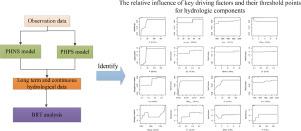Ecological Modelling ( IF 3.1 ) Pub Date : 2021-05-13 , DOI: 10.1016/j.ecolmodel.2021.109586 Renhua Yan , Junfeng Gao

|
Quantifying the relative effect of driving factors on polder hydrological processes and identifying the key factors are prerequisites to adopting effective measures for alleviating flooding, soil loss, and eutrophication. Based on the output results of calibrated Polder Hydrology and Nitrogen modeling System (PHNS) and Polder Hydrology and Phosphorus modeling System (PHPS), the boosted regression tree (BRT) model screened key influential factors and identified the corresponding threshold point values in a typical Chinese agricultural polder. Temporal changes in discharge and soil erosion were most sensitive to weather factors, while those of nitrogen and phosphorus exports were mainly influenced by human management actions. Precipitation was the largest contributor to the temporal variation of discharge (51.5%), soil erosion (69.4%). Vegetation cover and management factor of dryland C2 (34.5%) defined as the ratio of sediment loss from cropland to the corresponding loss from clean-tilled and continuous fallow, and phosphorus fertilization application to paddy field (30.7%) were the two determinants of phosphorus export, whilst surface water level to stop pump drainage (48.2%) had the largest contributions to nitrogen export. Precipitation from 0 to 50 mm/d contributed to a significant increase in discharge, soil erosion and nitrogen and phosphorus exports. Vegetation cover and management factor of paddy field C1 under 0.28 contributed to an elevated risk of nitrogen export, and C2 below 0.34 facilitated soil loss and phosphorus export.


























 京公网安备 11010802027423号
京公网安备 11010802027423号